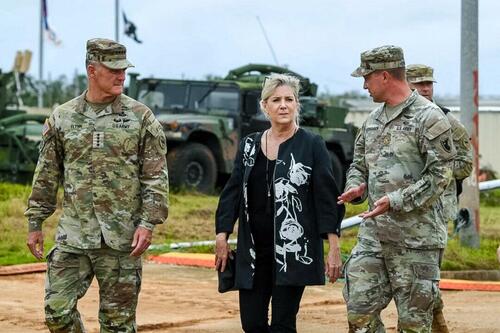US Army Revises Standards On Prohibited Extremist Activity
Authored by Ryan Morgan via The Epoch Times (emphasis ours),
The U.S. Army issued new, more specific guidance on Wednesday to address extremism within its ranks and ensure disciplinary action against those who engage with or promote extremist views.
Secretary of the Army Christine Wormuth signed off on a pair of memos, published on June 26, that refine how the service will handle protests and extremist or gang activity within the ranks, and report suspected prohibited behavior. One memo a directive for “Handling Protest, Extremist, and Criminal Gang Activities“ and the other is a directive for ”Reporting Prohibited Activities.”
The memo on Handling Protest, Extremist, and Criminal Gang Activities states that prohibited activity within the Army can include distributing extremist materials online. This new Army memo reinforces a policy approach articulated by the U.S. Department of Defense in a November 2021 memo, which states that “an action taken to replicate content from one online location to another” can qualify as distributing extremist content online. The new Army memo now states the prohibited online distribution of extremist activity can include liking, sharing, and “re-tweeting” said content.
“Military personnel are responsible for the content they publish on all personal and public internet domains, including social media platforms, blogs, websites, and applications,” the memo states.
The Army’s existing policy, updated in July of 2020, had previously said prohibited online conduct could include “hazing, bullying, harassment, discriminatory harassment, stalking, retaliation, or any other types of misconduct that undermines dignity and respect” but was less specific about online extremist activity, stating only that “military personnel must reject participation in extremist organizations and associated cyber activities.”
The new memo on Handling Protest, Extremist, and Criminal Gang Activities also states soldiers who “knowingly” display paraphernalia, words, or symbols in support of extremist activity, including on flags, clothing, tattoos, and bumper stickers—whether on or off a military installation—can run afoul of the Army’s prohibitions on extremist behavior.
The new memo does not provide an exhaustive list of what paraphernalia, words, or symbols may meet their definition of extremist material but does offer a definition of views and activities the Army includes in its definition of extremism:
- Advocating or engaging in the use of unlawful force or other illegal means to deprive individuals of their rights under the U.S. Constitution or in any states, territories or political subdivisions thereof.
- Advocating or engaging in unlawful force to achieve goals that are political, religious, discriminatory, or otherwise ideological in nature.
- Advocating, engaging in, or supporting terrorism.
- Advocating, engaging in, or supporting the overthrow of the federal government, or state, territory, and local governments using force, violence, or unconstitutional or other unlawful means.
- Advocating or encouraging military, civilian, or contractor personnel within the [Department of Defense] DOD or U.S. Coast Guard to violate laws or disobey lawful orders.
- Advocating widespread unlawful discrimination based on race, color, national origin, religion, sex (including pregnancy), gender identity, or sexual orientation.
The memo states that Army commands have several options for recourse against soldiers promoting those views. They include legal action under the military justice system, known as the uniformed code of military justice. Commands may also choose adverse administrative actions against soldiers alleged to have violated these prohibitions on extremist activity, including involuntary separating of soldiers, reassigning soldiers, revoking their security clearances, barring soldiers from continued service, or “other administrative or disciplinary action deemed appropriate by the commander, based on the specific facts and circumstances of the particular case.”
The Second Memo
The second memo, regarding how military officials should report suspected prohibited activity, seeks to establish a process for reporting suspicious activity to the DOD Deputy Inspector General (DIG) for Diversity and Inclusion and Extremism in the Military.
Appropriate Army authorities who receive an allegation that a soldier engaged in a prohibited activity must notify the soldier’s commander or another appropriate authority and the appropriate Army inspector general within 30 calendar days if that soldier is in the active component and within 60 calendar days if that soldier is in the Army’s reserve component. The Army inspector generals must then forward information they receive along to the DOD Deputy Inspector General for Diversity and Inclusion and Extremism in the Military within another 15 calendar days of receiving said notification.
Commanders are also instructed that they must ensure that a soldier’s permanent record in the Army Military Human Resource Record (AMHRR) is annotated if that soldier has received a court-martial conviction, nonjudicial punishment, or general officer’s memorandum of reprimand for actively participating in extremist activities.
The reporting memo instructs Army commanders to periodically remind soldiers to avoid engaging in extremist activity.
The memo also advises Army commanders that they should consider command-directed mental health evaluations and financial counseling sessions for soldiers showing signs of potential involvement in extremist activities.
Tyler Durden
Wed, 06/26/2024 – 20:20
via ZeroHedge News https://ift.tt/3j058Kr Tyler Durden
